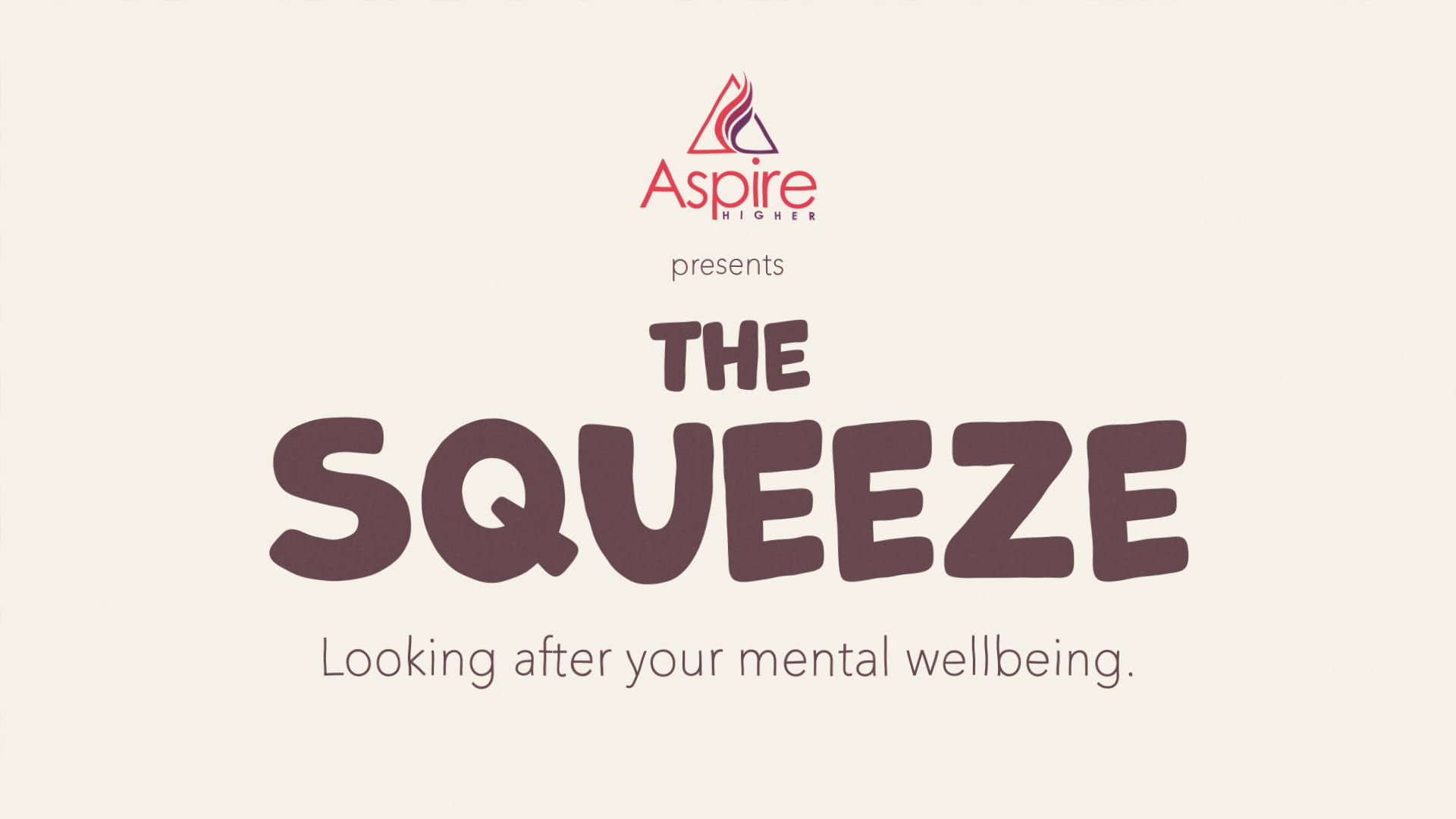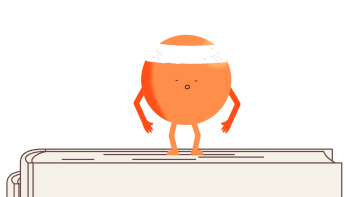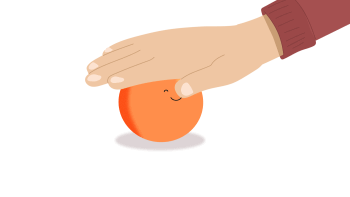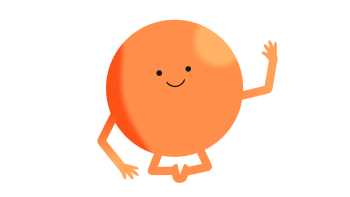Wellbeing
This wellbeing module focuses on the 5 steps to wellbeing, as shared by the NHS. Each step will focus on some key learning objectives, an activity and reflection for students to participate in, either at home or in school during their tutor time. The aim of this module is to focus in on wellbeing for students, paying close attention to coping strategies and ways to look after your mental wellbeing.
Get started by watching these videos
Up Next, follow along with the activities below
According to NHS guidance, there are 5 steps you can take to improve your mental health and wellbeing. We have provided an activity to follow under each of the 5 areas. Trying these activities could help you feel more positive and able to get the most out of life.
-
Duration
20 Minutes
What you need
A stopwatch, fitbit or mobile phone to count steps.
Activity:
Welcome to ‘Get moving with Squeezy”. ‘Interval exercise’ and ‘high intensity workouts’ promote positive impact of short and fast physical movement, getting the heart pumping and blood flowing. This not only improves physical fitness but also mental wellbeing. Take a look at the video links below to watch some examples of high intensity workouts.
You must work in small groups, pairs or individually, competing to see whom can measure the most steps on their device within 30 seconds. You can use a stopwatch, fitbit or a step counter app to measure steps. Each person will get three chances to measure steps in the hope they are able to improve the result each time. Once finished, share results with each other.
In groups, pairs or individually you will then work on creating your very own ‘high intensity workout’ plan. You need to think about what other body movements you could count and measure within a 30 second period and how many times you would need to repeat them to feel as though you have had a good workout.
Reflection:
After the session reflect on how you felt after the high intensity interval exercise. How you feel this approach can be beneficial compared to other forms of exercise or sport?
Teachers notes -
Duration
20 Minutes
What you need
Fingerspelling alphabet chart.
Activity:
Applying simple methods, one step at a time you can learn and absorb a new skill. Learning a skill that could also help others when in need is well worth it. Take a look at this example.
You will learn how to sign the opening dialogue ‘hello, what is your name’ and ‘hello, my name is…’. You will then practice signing alone, in pairs or within a group, referencing the chart until you no longer require it.
Learn how to finger spell your own name using the Fingerspell alphabet chart.
Reflection:
After the session, reflect on how you feel now you know how to communicate in sign and relate that empathy you have towards people with hearing problems whom require the use of it. Appreciate the commitment and practice it requires to memorise each sign.
Ultimately, a skill is a series of connections in your brain. As you practice a set of actions, your brain creates these connections for you. While that may seem like great news, that’s not always the case. The brain doesn’t discern what is good and what is bad for you. That’s how bad habits get created. It just records your actions and stores it in your memory.
Teachers notes -
Duration
20 Minutes
What you need
Pen and paper for journaling your thoughts.
Activity:
Work individually or in groups to read and answer questions on the below scenario.
Jayden is feeling really tired and frustrated at the moment. He snapped at his mum this morning and fell out with his best friend over something he thought was important, but he has realised it may have been silly. Jayden isn’t sure why he has been feeling this way and doesn’t know who to talk to. His homework has been piling up and he has an exam next Monday. His mum said he’s not allowed to go out until he has finished his work and revision, but he’s seen his friends posting on Instagram going out after school. They look like they are having a really fun time without him. Jayden doesn’t want to feel this way, he wants to go out and make up with his friends again.
Think about what you would do if you were Jayden.
How could Jayden improve or change the situation?
Who could Jayden talk to about the way he’s feeling?
How could Jayden reconnect with his friend?
Reflection:
After this activity it is important to reflect on how connecting with others can improve your mental wellbeing. Take a moment to write down or share the challenges or frustrations you have faced and who you could connect with or talk to for support. Sometimes you aren’t aware of why you are experiencing certain emotions, so it is important to have these conversations.
Additional resources:
- MIND has some great tips for how to manage loneliness – www.mind.org.uk
- The YoungMinds resource library is full of tool kits, publications and useful reports. – www.youngminds.org.uk/resources/
-
Duration
20 Minutes
What you need
Pen and paper for brainstorming your ideas.
Activity:
Welcome to ‘Giving with Squeezy’. There are many ways learners can support local charities. One is to raise money for them so that they can best manage the necessary impact they can achieve with more funds. Learners may need to hire a person to help or buy a new piece of specialist equipment. Therefore it is more productive to aim to raise money for a charity than think of other ways you can help them.
You can find some fundraising tips at www.justgiving.com
Alone or in small groups you will first research and select a local charity they would like to support. Perhaps learners or someone they know has a link with a local charity or learners can research online to look for one they feel a connection with.
Once decided learners will brainstorm ways they could raise money for the charity. Create a spider diagram using ‘Sponsorship’, ‘fundraising event’, ‘volunteer’, ‘raise awareness’ and ‘sell items’ as the headings. Such as a bake sale, doing some gardening for someone or selling some tye dyed t-shirts.
It is important to note that depending on the method of fundraising appropriate supervision may be required. You must ensure you follow your own Safeguarding policy to ensure this is monitored and carried our safety.
Reflection:
After the session reflect on how you felt when researching the local charities. Were you surprised how many there were? Did you feel sad? Did you feel motivated by empathy? Encouraged to do more? Then you can reflect on the ideas generated. The endless number of creative ways you can help, whether alone or as part of a team. Now get out there and start supporting your local charity of choice.
Teachers notes -
Duration
20 Minutes
What you need
Internet connection.
Introduction:
Start by watching this film, our well being expert will introduce learners to the concept of mindfulness and being in the present moment.
Activity: Explicit Instruction/Teacher modeling
Work your way through the guided practice virtual video by clicking the image below. Make sure to participate and follow along.
Reflection:
You listened to a three stage breathing space meditation on the activity video. It’s also available as an audio file here. These are ideal pauses in your day. To help you pause, it’s good to decide points in the day when you would do this. Reflect for yourself when you could do this e.g. first thing in the morning, before lunch etc – pick three times in the day. Write down your experience of the meditation and your times when you want to pause.
Teachers notes
Reflection activity

Taking the time to reflect is how we develop, equipping ourselves to successfully navigate our lives. This step will help you identify the impact of carrying out these activities. After these experiences we hope you will feel confident to write your own 5 steps to wellness action plan. This is a great way of promoting a continuous state of wellness.
Download Activity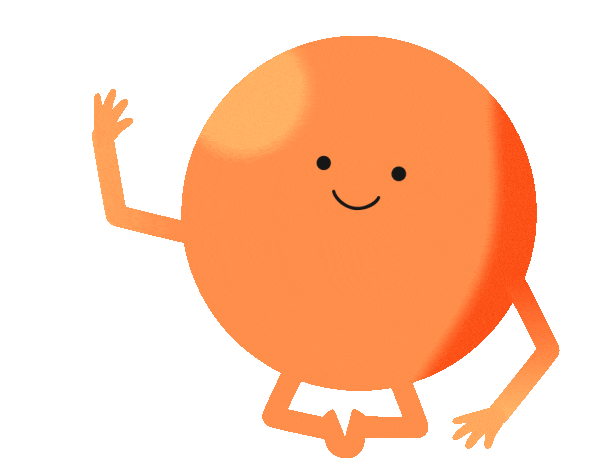
Additional resources
For Teachers
- Breathing with Squeezy >> Download PDF
- Activities – Teaches notes >> Download PDF
- MIND has some great tips for how to manage loneliness – www.mind.org.uk
- The YoungMinds resource library is full of tool kits, publications and useful reports. – www.youngminds.org.uk/resources/
- The Education Hub – Mental health resources for children, students, parents, carers and school/college staff
For Students
- MIND has some great tips for how to manage loneliness – www.mind.org.uk
- The YoungMinds resource library is full of tool kits, publications and useful reports. – www.youngminds.org.uk/resources/
- The Education Hub – Mental health resources for children, students, parents, carers and school/college staff
- Get Moving
- Learning a new skill
- Connecting
- Giving
- The present moment

